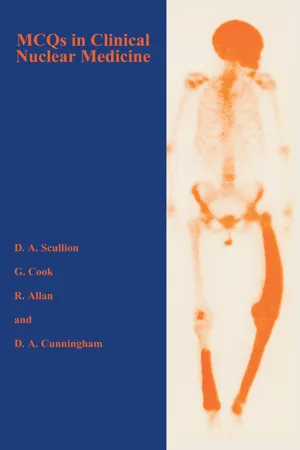
eBook - ePub
MCQS in Clinical Nuclear Medicine
- 230 pages
- English
- ePUB (mobile friendly)
- Available on iOS & Android
eBook - ePub
MCQS in Clinical Nuclear Medicine
About this book
Written specifically for those candidates about to sit for the FRCR part II examination, the format will also be of use to other trainee radiologists who are not specialists in this field. It contains a number of multiple choice questions covering all aspects of nuclear medicine with particular emphasis on the more common techniques, ie bone, renal and lung scanning. Extensive use is made of review articles, and important articles in the major nuclear medicine journals and references are provided.
Frequently asked questions
Yes, you can cancel anytime from the Subscription tab in your account settings on the Perlego website. Your subscription will stay active until the end of your current billing period. Learn how to cancel your subscription.
No, books cannot be downloaded as external files, such as PDFs, for use outside of Perlego. However, you can download books within the Perlego app for offline reading on mobile or tablet. Learn more here.
Perlego offers two plans: Essential and Complete
- Essential is ideal for learners and professionals who enjoy exploring a wide range of subjects. Access the Essential Library with 800,000+ trusted titles and best-sellers across business, personal growth, and the humanities. Includes unlimited reading time and Standard Read Aloud voice.
- Complete: Perfect for advanced learners and researchers needing full, unrestricted access. Unlock 1.4M+ books across hundreds of subjects, including academic and specialized titles. The Complete Plan also includes advanced features like Premium Read Aloud and Research Assistant.
We are an online textbook subscription service, where you can get access to an entire online library for less than the price of a single book per month. With over 1 million books across 1000+ topics, we’ve got you covered! Learn more here.
Look out for the read-aloud symbol on your next book to see if you can listen to it. The read-aloud tool reads text aloud for you, highlighting the text as it is being read. You can pause it, speed it up and slow it down. Learn more here.
Yes! You can use the Perlego app on both iOS or Android devices to read anytime, anywhere — even offline. Perfect for commutes or when you’re on the go.
Please note we cannot support devices running on iOS 13 and Android 7 or earlier. Learn more about using the app.
Please note we cannot support devices running on iOS 13 and Android 7 or earlier. Learn more about using the app.
Yes, you can access MCQS in Clinical Nuclear Medicine by Rosie Allan,Gary J. R. Cook,Deborah Cunningham,David Scullion in PDF and/or ePUB format, as well as other popular books in Medicine & Clinical Medicine. We have over one million books available in our catalogue for you to explore.
Information
Chapter 1
Bone scintigraphy
Malignancy
Q. 1.
| a. | In multiple myeloma the MDP bone scan is usually abnormal. |
| b. | Increased 99mTc MDP uptake into metastatic deposits two months after chemotherapy indicates failure of response and progression of disease. |
| c. | A solitary rib hot spot in a cancer patient usually represents benign disease. |
| d. | A rib hot spot which is present over a year is likely to represent a simple healing fracture. |
| e. | A solitary area of abnormal uptake in a patient with a known primary cancer with normal plain film appearances is likely to be benign. |
A. 1.
| a. | T | Bone scintigraphy is less sensitive than plain film radiography in detecting myeloma deposits as myeloma tends not to excite an osteoblastic response. It is still possible to see some areas of increased activity however and with modern cameras, resolution has improved to an extent where it is possible to discern cold lesions where bone has been replaced. |
| b. | F | The flare response, with increasing activity in the areas of metastases following chemotherapy, may persist for three months or more and indicates healing with successful treatment. Scans carried out before this time will therefore not be able to differentiate progressive disease from successful chemotherapy. |
| c. | F | About 40% of solitary rib lesions turn out to be metastatic (Nucl Med Commun, 1995; 16:834–837). Solitary rib lesions may also be due to minor trauma which may not even be recalled by the patient. In the context of breast carcinoma, lesions in the upper anterior ribs are often secondary to radiation necrosis. |
| d. | F | A simple traumatic fracture would be expected to show some resolution by this time. Metastases or pathological fractures from radiation necrosis would be expected to persist for longer. Metastatic rib lesions are often scattered and tend to grow along the bones with time rather than remaining focal. |
| e. | T | Bone scintigraphy is much more sensitive than plain film radiology in detecting metastases, often showing pathology many months before plain film changes. Surprisingly however less than 20% of bone scan lesions with negative plain radiology turn out to be malignant. (Radiology, ... |
Table of contents
- Cover
- Half Title
- Title Page
- Copyright Page
- Table of Contents
- Preface
- 1 Bone scintigraphy
- 2 Lung imaging
- 3 Renal radionuclide studies
- 4 Endocrine imaging
- 5 Gut and infection imaging
- 6 Cardiac imaging
- 7 Tumour imaging
- 8 PET imaging
- 9 Miscellaneous
- Appendix
- Bibliography